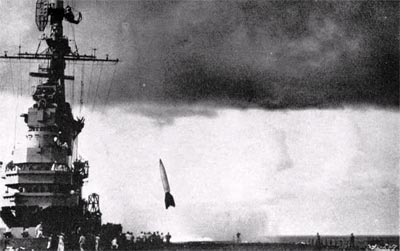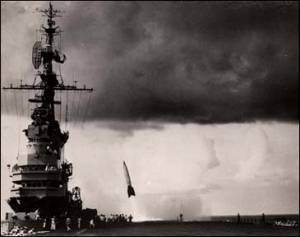|
V2 launched from USS Midway |
|
|
..
Ocean-based launch: extending a successful approach to new applications The US Navy’s only attempt to launch a liquid fueled rocket from an aircraft carrier. Operation Sandy involved the September 6, 1947 launch of a V-2 rocket from the deck of the USS Midway. A newsreel account of the launch can be viewed online. The V-2 broke up shortly after liftoff (D.M. Norrell, C.R. Browning, K. Burns, Operation Sandy, AIAA 2006-7470), mercifully sparing the aircraft carrier any exposure to flame and blast but causing great concern in naval circles. Viewers of the newsreel will observe the immediate tilt of the rocket near liftoff, as also visible in the photo. In 1948 Operation Pushover was carried out, in which mock ship’s decks were constructed in a desert and two V-2s were deliberately exploded atop these landlocked simulations of seagoing structures. The catastrophic damage that resulted convinced the Navy to abandon liquid-fueled missiles for shipboard use and led to the development of solid-fueled naval missiles. |
|
|
..
On a cloudy September day, two years after the end of World War II, a captured German V-2 rocket was successfully test fired from the USS MIDWAY. This was a historic first in the annals of naval warfare. Naval records indicate the test took place several hundred miles off the East Coast of the United States with the country's top naval and civilian rocketry experts in attendance. The goal of the test? To determine if modern rockets could be fired from naval platforms and perform as intended. At that time, there was some question as to whether major modifications might be necessary for shipboard launches of missiles. The V-2 successfully lifted off the USS MIDWAY and was exploded about six miles away, just a few minutes after launch. Although the test took place on September 6, 1947, the results and photography were not released to the public until the next month, on October 13, 1947. Rear Admiral D.V. Gallery, Assistant Chief of Naval Operations for Guided Missiles, declared the test a success. The MIDWAY missile test is now considered to have been the dawn of naval missile warfare. Source: USS Midway Navy Buddies Related Links: |
|
|
F-0014 Operation Sandy
Uploaded on Apr 22, 2011
From the Summer of 1947, Task Group 41.16 Operation Sandy, V-2 rocket tests from the USS Midway. From the archives of the San Diego Air and Space Museum http://www.sandiegoairandspace.org/re... Please do not use for commercial purposes without permission. |
|
| From the Sea to the Stars
Chapter 0.1: Before the Beginning (Pre-1940s) 0.1.1 Heavenly Satellites: The Naval Observatory Operators of early Navy ships, like all seafarers, depended on accurate observation of the sun, moon, planets, and stars for navigation when sailing beyond sight of shore landmarks. The Naval Observatory was established at Washington, D.C. in 1830 to: improve the knowledge of heavenly bodies; publish their accurate positions and movements; and develop improvements in the equipment, including chronometry, used to make accurate measurements of them--creating a strong foundation for Navy's interests in space applications a century and a half later. 0.1.2 Space physics was understood The knowledge required to place military satellites in orbit predated the capability to do so by a considerable period. The laws of motion of the planets, artificial satellites, and eventually ballistic missiles were discovered by Johannas Kepler in the early 1600s. Over the years they became well understood by military scientists and mathematicians. 0.1.3 Early visions of military space applications During the century leading up to World War II there was no lack of imagination as to the potential applications of space. In 1865, for example, French writer Jules Verne had fired imaginations with his famous book, “From the Earth to the Moon"; his spaceship was remarkably prophetic of developments a century later. Launch was from a giant cannon, and spacecraft recovery was by splashdown in the sea. (At a 1987 AIAA/DARPA Conference at the Naval Postgraduate School, an electromagnetic gun was actually proposed as a modern means for placing satellites in orbit.) A very popular comic strip during the 1930s was "Buck Rogers in the 25th Century", whose rocket-propelled hero crossed the Galaxy in a variety of spacecraft. The Russians appear to be the first to have seriously contemplated exploitation of space; in 1903 Konstantin Tsiolkovsky published a report on rocket propulsion for space vehicles. Several treatises on space travel and rocketing followed after the Communists came to power. The USSR's "Society for the Study of Interplanetary Travel" was founded in 1924 (but disbanded in the 1930s). The first U.S. space-advocacy group, the "American Interplanetary Society", was founded in 1930. Even before World War II, and certainly during World War II, the advantage that naval aircraft offered as observation platforms for wide-area surveillance, reconnaissance, early warning, and targeting at sea became obvious. These operations gave the Navy experience and insight into the potential advantages of the even higher altitudes of artificial earth satellites that were to support naval and military operations in the future (a lesson also learned by the Army Air Corps, soon to become the Air Force.) 0.2. Key developments in rocketry Rockets were recognized early as the only practical way to put spacecraft into orbit The physical laws governing today's rocket propulsion (as well as the movements of objects in space) had been developed by Isaac Newton by 1687. Rocket propulsion for military weaponry was developed initially in China and was refined during the Eighteenth century by Britain, Austria, and Russia. The theory of rocket power was highly refined by Russian scientists in the early 1900s. In the United States, Robert Goddard conducted the first launch of a liquid?propellant rocket in 1926. During the 1930s, rocket research continued to go forward in Germany, the Soviet Union, and the U.S. By the 1940s, the only ingredient really missing for the development of space for naval and other applications was rocket propulsion powerful enough to lift spacecraft into orbit. U.S. Navy scientists and engineers contributed to progress with rockets. From 1941 to 1945, the Navy contracted with the California Institute of Technology to establish and operate the Naval Ordnance Test Station at China Lake, California, and tests there included rockets for naval weapons. At the Engineering Experiment Station, Annapolis, Maryland, a Navy team working on jet-assisted take-off (JATO) rockets for seaplanes made discoveries concerning spontaneous ignition of liquid propellants, that contributed significantly to the U.S. rocket development program. During World War II, the Navy established a jet-Propelled Missile Board which, in response to the threat to Navy ships from Japanese Kamikaze attackers, authorized work on a surface-to-air missile called the "Lark." The Lark featured a liquid-propellant main engine and solid-propellant booster, with midcourse correction, semi-active homing, and terminal guidance. (The Lark missile was not ready before hostilities ended, but was tested after the war.) In World War I, the Germans had developed long-range artillery and bombarded Paris from the German lines; because of this, the Treaty of Versailles forbade future German development of heavy artillery. The treaty, however, said nothing about rockets. During World War II, German rocketeers under the technical direction of Wernher von Braun developed the powerful V-2 rocket-powered missiles. In 1931, the German military established a rocket research facility at Kummersdorf Weapons Range, near Berlin. The first civilian employee at this facility was Wernher von Braun. In 1937 the German rocket facility was moved to Peenemunde on the Baltic Coast. The first test flight of a V-2 rocket was made in October 1942, and the V-2 became operational in September 1944, only a few months before the end of World War II in Europe. Germany bombarded London and both Antwerp and Liege, Belgium with thousands of V-2s from German mobile bases during the last months of the war. At the end of World War II, the Soviet Army captured most of the German V-2 production facilities, while the Western allies captured the R?D facilities .and personnel, including von Braun, as part of "Operation Paperclip". With the help of General Electric engineers the Army assembled about eighty V-2 rockets from the captured parts. The U.S. now had rockets capable of lifting payloads into space (but not yet into orbit). The U.S. Army offered some of the captured V-2s to the U.S. Navy, and the offer was accepted by the Naval Research Laboratory (NRL), and by the Navy-sponsored Applied Physics Laboratory (APL) of Johns Hopkins University. By 1945, both the Naval Research Laboratory and the Applied Physics Laboratory were using the captured German V-2 rockets for atmospheric soundings. In 1947 the Navy launched a V-2 rocket from the deck of the USS Midway (CVA-41) to demonstrate that such weapons could be launched at sea. Von Braun and his closest colleagues had wanted all along to launch artificial satellites, not weapons. When Allied Armies closed in on Germany, the rocket scientists had managed to surrender to the western allied armies, not the Soviets. They soon ended up at the U.S. Army Ballistic Missile Agency (ABMA); Huntsville, Alabama. There they worked on rockets even more powerful than the V-2s. The principal purpose of this work was to develop a capability to carry nuclear warheads half-way around the world using ballistic missiles. The goal of placing satellites into orbit was a distant second priority of the Army rocket program until 4 October 1957 when the Soviets placed the first man-made object in orbit about the earth. SOURCE: Naval History |
|
| FAIR USE NOTICE: This page contains copyrighted material the use of which has not been specifically authorized by the copyright owner. Pegasus Research Consortium distributes this material without profit to those who have expressed a prior interest in receiving the included information for research and educational purposes. We believe this constitutes a fair use of any such copyrighted material as provided for in 17 U.S.C § 107. If you wish to use copyrighted material from this site for purposes of your own that go beyond fair use, you must obtain permission from the copyright owner. | |
| ~ MENU ~ |


